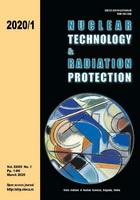
MOLECULAR DYNAMICS AND REACTION KINETICS ANALYSES OF GAMMA RADIATION IMPACT ON CONCRETE HYDRATION
Pages: 1-15
Authors: Quentin Faure and Tatjana JevremoviŠAbstract
MOPAC and LAMMPS molecular dynamics codes and reaction kinetics code based on multi-ionic continuum-based model are used to analyze the impact of gamma radiation on concrete hydration. The experimental studies showed that while cured with the low gamma dose concrete shows a statistically significant increase in its strength compared to conventionally cured concrete. The potential reason is the interactions of gamma rays with water causing concrete faster hydration. The question then to ask is would the higher gamma dose enhance the concrete curing further producing its higher strength. This paper provides in-depth numerical analyses of the high-dose gamma radiation effect on concrete based on molecular dynamics and reaction kinetics models. Under these conditions, it is assumed that gamma radiation interacting with water within the concrete induces water radiolysis. These numerical simulations show that the reactivity is generally increased in the presence of electrophiles. However, the early hydration models of tricalcium silicate (alite) and dicalcium silicate (belite) with H+, OH–, and H2O+ show that the hydration process is slowed down leading to a lower concrete strength. Additionally, the reaction kinetics model used to estimate the effect of [OH–] on tricalcium silicate hydration shows that an increase or decrease of [OH–] during tricalcium silicate hydration can respectively slow down or enhance its rate of hydration. The dose necessary to produce the water radiolysis resulting in varying [OH–] during tricalcium silicate hydration is required to be extremely high and therefore, will damage the concrete structure itself. This leads to the conclusion that increasing the gamma dose to concrete above that used in the experimental studies in order to induce water radiolysis will not improve concrete strength, therefore water radiolysis is not the required condition for improving concrete strength when cured under gamma radiation.
Key words: LAMMPS, MOPAC, early concrete hydration, multi-ionic continuum-based model, alite, belite, water radiolysis, gamma radiation
FULL PAPER IN PDF FORMAT (3,18 MB)
